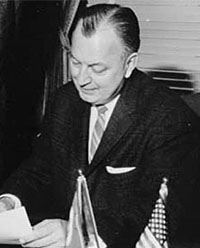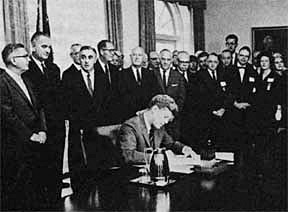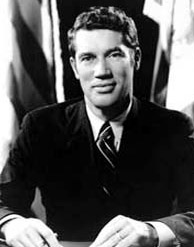The Minnesota Governor's Council on Developmental Disabilities
FORTY-FIVE YEARS OF HISTORY 1971-2016
The introductory article covers the first five years [1971-1976] of the Minnesota Governor's Council on Developmental Disabilities (Council), with brief background material on the advocacy and legislation that preceded the establishment of the Council. Future articles will move the history along in five-year segments to bring the Council's work to the present.
Historical Background:
For the early national history of the institutional confinement of children and adults with developmental disabilities refer to the section Parallels in Time: A History of Developmental Disabilities on this site, https://mn.gov/mnddc/parallels/index.html.
In the 20th Century, institutional living was the norm for individuals with developmental disabilities. By the late 1940s, family members formed the Parent Movement nationally in response to the overcrowding and increasingly deplorable conditions in the state institutions. Throughout the following decades, the Parent Movement, that spawned groups like the Arc, fought in the media, in courts and in the halls of government to improve conditions in institutions and provide services for people with developmental disabilities.
1960s – Activism and Progress:

Governor Elmer L. Andersen
The 1960s brought the activism of the civil rights and women's movements and with it a realization that it was not only racial and gender conditions that were discriminatory in America. The Parent Movement continued to work for equal treatment for their family members with disabilities.
In Minnesota, Governor Elmer L. Andersen funded a pilot project for four day activity programs. Adult children with developmental disabilities, who lived at home, now had a place to have socialization and recreation. As increased public attention was given to citizens with disabilities, it became clear that proper training and education should be provided.
The ultimate goal became the closing of the institutions and the creation of housing in communities. When John F. Kennedy became President in January 1961, the Parent Movement had an ally. On October 11, 1961 President Kennedy issued a statement that launched a Panel on MR which began:
The manner in which our Nation cares for its citizens and conserves its manpower resources is more than an index to its concern for the less fortunate. It is a key to its future… we as a nation have for too long postponed an intensive search for solutions to the problems of [individuals with intellectual disabilities]. That failure should be corrected.
[Full text, https://mn.gov/mnddc/parallels2/pdf/60s/62/62-salinger-pr.pdf]

President John F. Kennedy Issuing Statement
In January 1963 the Panel issued its recommendations for research, needed resources, treatment and care, education and employment training, legal protection, and the development of federal, state and local programs. The importance of addressing "years of general ignorance, prejudice and superstition" was acknowledged as a major hurdle for progress.
The MR and Community Mental Health Centers Construction Act was passed on October 31, 1963. It contained three construction programs; established centers to conduct research into causes and treatment of intellectual disabilities, developed University-affiliated facilities to train professionals, and constructed community facilities so people could have a place to obtain services in their communities.
Once the Federal government became involved in the issues related to individuals with intellectual disabilities, significant legislation was enacted. President Lyndon Johnson established the President's Committee on MR in 1966 that focused on residential care, funding for training for support personnel and volunteers, and making services available to all regardless of income.
Public Law 91-517:
In 1970 Congress passed Public Law 91-517, the Developmental Disabilities Services and Facilities Construction Act. The goal of this legislation was to assist and fund the States "in developing a plan for the provision of comprehensive services to persons affected by… developmental disabilities", with a focus on deinstitutionalization and developing alternative housing in communities as a priority. Federal Funding was available to implement the State plans for facilities construction and "other purposes".
The law covered services and facilities for those with categorical developmental disabilities that began at birth or early in life and continued indefinitely, and was therefore a substantial disability.
Guidelines were given for the State to establish a Planning Council that would develop an annual plan and advise the State Governor on the services that would improve the quality of life for persons with developmental disabilities. And throughout the process, the importance of preserving the rights and dignity of the individual was a priority.
The law specifies that the Council organize and coordinate the services offered by existing agencies and other sources (physicians, therapists and researchers, social workers, educators, rehabilitation specialists, advocate groups and families), and provide grant monies to secure services and fund new initiatives and construction of facilities. Evaluation of all the activities and projects undertaken by the Council is an integral part of the law.
1970s – Minnesota Governor's Planning and Advisory Council on Developmental Disabilities:
In response to Public Law 91-517, Governor Wendell Anderson, elected in the fall of 1970, began the work that ultimately led to establishing the Governor's Planning and Advisory Council on Developmental Disabilities. He directed W. Dennis Pederson of his staff to act as Project Director and handle the implementation of the requirements of the law. An Ad Hoc Committee on Developmental Disabilities was formed to work on the State Plan that was submitted to the Federal government by the April 15, 1971 deadline. Once the Plan was approved, a permanent Council was formed in October 1971 with Jane Belau, Rochester, appointed as Chairperson.
Developing the State Plan required an understanding of what was needed to accomplish Council goals, examining the present status and availability of services and supports, and recognizing the network of Council partners and initiatives being proposed. In addition, it was important for the Council to objectively understand the history of what had gone before. An overview of legislation enacted and programs recommended in Minnesota since 1851 is contained in the January 1969 publication, MN MH-MR Program in Perspective [https://mn.gov/mnddc/past/pdf/60s/69/69-DPW-MRP.pdf].

Governor Wendell Anderson
With the Council membership and State Plan in place, $184,000 in Federal funds were committed to Minnesota for "…planning, administration, provision of services and construction of facilities for persons with developmental disabilities." The grant process was established and grants approved. The Governor and Council dealt with studying the feasibility of institution closings as well as the "construction" of services, programs and facilities during the first five years.
Two important issues that began in the first years of the Council's work will be covered more fully in the next segment of this narrative:
- Welsch Case: The Welsch lawsuit, filed in Minnesota in 1972 and dismissed in 1989, challenged the living conditions of individuals with developmental disabilities who were residing in Minnesota's state institutions.
- The CAIR [Community Alternatives and Institutional Reform] Committee formed in 1974 to develop a systematic plan for returning persons with developmental disabilities in state institutions to community settings based on their individual needs
Recap:
Governor Wendell Anderson's correspondence in the State Archives shows how involved he and his staff were with the planning and operations of the Developmental Disabilities Council in its formative years. Letters were sent out under his signature to reply to the concerns and questions of not only the interested groups that were participating in the work, but also the relatives and friends of individuals with developmental disabilities who were being impacted by the work of the Council.
As the first five years of the Council came to an end, the framework was in place to educate the public, build facilities in communities for those leaving institutions, support programs and, more importantly, gain equality for Minnesota's citizens with developmental disabilities.




